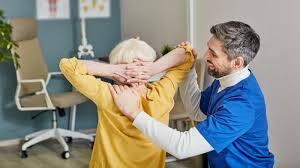
How To Check for Scoliosis in Older Adults
Are you concerned about changes in your posture or back pain? These could be signs of scoliosis, a spinal condition that can develop or worsen in older adults. While it's often associated with teenagers, recognizing the early symptoms in older individuals is crucial for timely diagnosis and treatment.
That said, this article will explore the critical indicators of scoliosis in older adults, guiding how to assess your spine and when to consult a healthcare professional.
What Is Scoliosis?
Scoliosis is a medical condition characterized by an abnormal lateral curvature of the spine. Instead of the spine running straight down the back, it curves to the side, forming either a ‘C’ or ‘S’ shape. The curve can occur at any part of the spine but most commonly affects the upper (thoracic) or lower (lumbar) regions. In severe cases, when the curvature progresses and causes significant discomfort or affects mobility, spinal surgery for scoliosis Singapore may be considered as a treatment option to correct the abnormal curvature and prevent further complications.
How to Identify Scoliosis in Older Adults
Checking for scoliosis in older adults involves both physical examination and potentially imaging tests. Here's a step-by-step guide:
1. Observe Posture
One of the first signs of scoliosis in older adults can be observed in their posture. As scoliosis progresses, it often leads to visible asymmetry. You may notice that one shoulder is higher than the other or that the waistline appears uneven, with one side of the waist standing higher or protruding more prominently. The hips can also become asymmetrical, where one hip may sit higher than the other or look more pronounced. Additionally, individuals may develop a natural lean to one side, which can be subtle or more apparent depending on the severity of the curve.
2. Forward Bend Test (Adam’s Test)
The forward bend test, also known as Adam’s test, is one of the simplest and most used assessments for scoliosis. In this test, the individual is asked to stand with their feet together and then bend forward at the waist, letting their arms hang down freely. This position makes it easier to observe any curvature of the spine. A significant hallmark of scoliosis is the presence of a rib hump, which appears on one side of the rib cage when the person bends forward. This rib hump is caused by the rotation of the spine and ribs, a feature commonly associated with scoliosis.
3. Check for Unequal Leg Length
Another simple yet essential step is to check for unequal leg length. Scoliosis can sometimes cause or be associated with a noticeable difference in leg length. Measuring the legs from the hip to the ankle can help determine if one leg is shorter than the other. When one leg is shorter, the spine compensates by curving, leading to postural changes and potential pain. This difference can contribute to or exacerbate scoliosis, especially in older adults. Even a small discrepancy in leg length can result in significant discomfort, impacting the way a person walks, stands, and moves.
4. Palpate the Spine
Palpating or feeling the spine can provide essential information about the presence and severity of scoliosis. By running your hand along the back, from the neck down to the lower spine, you can detect irregularities or bumps along the vertebrae that suggest a spinal curve. In older adults, scoliosis may not only present as a curve but also with areas of tenderness or pain, especially in the lower back.
5. Observe Range of Motion
Evaluating the range of motion in an older adult is another crucial step in detecting scoliosis. You can ask the individual to perform a variety of movements, including bending forward, backward, and side to side. Scoliosis can limit the flexibility and mobility of the spine, making certain movements difficult or uncomfortable.
6. Pain and Symptom Inquiry
Pain is a common symptom of scoliosis, especially in older adults, and inquiring about pain or discomfort is a crucial part of the assessment. Scoliosis in older adults often leads to chronic lower back pain, stiffness, and discomfort, particularly in cases of degenerative scoliosis, where wear and tear on the spine causes it to curve over time. In addition to back pain, older adults may report leg pain, numbness, or weakness due to nerve compression caused by the curvature of the spine.
7. Medical Imaging
While physical examinations are helpful, medical imaging is necessary to confirm a scoliosis diagnosis and assess the severity of the curvature. A standing X-ray is typically the first step and can provide a clear image of the spine’s alignment, showing any abnormal curvature. The X-ray helps determine the Cobb angle, which measures the degree of spinal curvature and provides insight into the severity of scoliosis. A Cobb angle of 10 degrees or more confirms the diagnosis of scoliosis.
8. Seek Professional Evaluation
If scoliosis is suspected, it’s essential to seek a professional evaluation from a healthcare provider such as a physical therapist, chiropractor, or orthopedic specialist. These professionals can perform a more thorough examination and recommend the best course of treatment. In older adults, scoliosis is often degenerative, meaning it develops due to age-related changes in the spine. A specialist needs to differentiate between scoliosis and other conditions that can cause similar symptoms, such as osteoporosis or spinal stenosis.
Conclusion
Scoliosis in older adults is a condition that can significantly impact the quality of life. By being aware of the signs and symptoms and taking proactive steps to assess your spine, you can increase your chances of early detection and effective management. Remember, if you notice any changes in your posture, uneven shoulders or hips, or persistent back pain, it's important to consult with a healthcare provider for a proper evaluation.